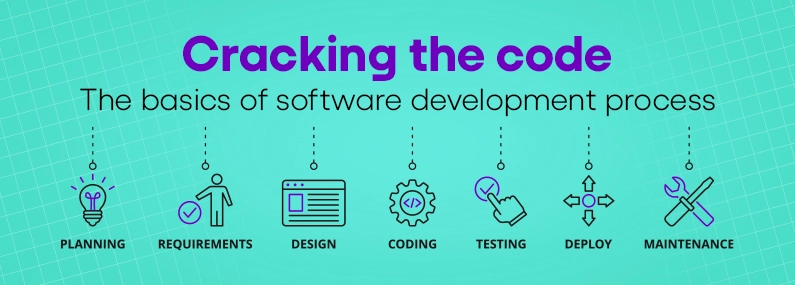All apps on your phone were nothing more than an abstract thought in someone’s head. Ever wondered how it transformed into the fully functional app you are using now?
Enter the Software Development Lifecycle (SDLC)—a systematic process that helps software engineers turn creative sparks into practical, polished software. From the initial concept to the final product, SDLC provides the framework for every step of the journey.
Let’s explore this fascinating process and uncover how ideas become the apps we rely on every day.
Breaking down SDLC step by step
The planning phase
Imagine planning a dinner party. Before shopping, you make a list of everything you need. Similarly, in this phase, teams gather all requirements to ensure a clear roadmap for building the software.
The design phase
Next, just like creating a house blueprint, software design outlines how the program will look and function. This plan ensures clarity before developers start coding.
The development phase
This is the building phase—assembling the pieces like constructing a robot. Developers write code to bring the software to life.
The testing phase
Testing ensures everything works. Does the software perform as expected? Bugs are identified and fixed during this critical phase.
The deployment phase
Finally, it’s launch time. The software is deployed for users, ready to serve its purpose—just like turning on a robot.
Much like nurturing a plant, software needs continuous updates and improvements. Iterative and agile development focuses on small, steady enhancements, ensuring the program evolves.
Writing code that’s built to last
Good code is like art. It is clear and organised for everyone to understand and ultimately solves the problem elegantly.
Clean code is key
Think of code as a room. A tidy, organised space is easier to navigate than a messy one. Using clear variable names, like weight instead of random letters like x, and adding comments helps make code understandable and easier to fix.
Track changes with version control
Version control tools, like GitHub, keep track of changes in your code, letting teams work smoothly and even revert to earlier versions when needed. It’s like saving drafts of a book so you can revisit older ideas anytime.
Stick to coding standards
Coding standards are like grammar rules for programmers. Following consistent naming conventions and formatting styles ensures that code is easy for others to read and collaborate on.
Documentation: The rulebook for code
Documentation is like the rules of a game – it explains how everything works so others can pick it up quickly.
Tools like GitHub’s README file provide a clear project overview, making collaboration much easier.
Mastering collaboration: How teams make magic happen
Picture a sport like football. The ball gets passed, players move in sync, and strategies are executed in harmony. In software development, the process is just as fluid and collaborative, with teams working together to achieve a shared goal.
Good communication and clear roles ensure that every step of the process aligns with the project’s objectives.
Take data science as an example:
- Data Cleaning Team: This team starts by refining raw data, removing errors, and organising it for use.
- Machine Learning Team: Once the data is clean, it’s passed to this team, which trains and tests models, adjusts parameters, and ensures accuracy.
- Deployment Team: After the model is ready, it’s handed over for deployment. This team makes the software live, often on platforms like AWS or other cloud services.
Each handoff is like passing the ball in a game—everyone must understand their role and work in harmony to ensure the project’s success.
Making progress one sprint at a time: The scrum
Just like a football match is divided into halves, Scrum divides work into short sprints. Teams regroup during intervals, assess progress, and adjust their strategy.
Tools like Kanban boards act as the team’s playbook, ensuring every player knows their role and tracks their responsibilities.
The role of project managers
The project manager is like the team’s coach. They create the game plan, track performance, and adapt when challenges arise.
If players fall behind or miss opportunities, the coach (manager) ensures adjustments are made—like substituting players or tweaking strategies—to keep the team on track.
The power clear goals and timelines in software development
Just as a football team plans its season, sticks to a strategy, and adjusts as needed, software teams must set realistic goals, define clear boundaries, and focus on improvement to ensure a smooth journey toward success.
Setting realistic timelines
The coach schedules matches, training sessions, and rest days, ensuring the team doesn’t overwork or underprepare. Similarly, in software development, teams create timelines that account for milestones, workload, and potential adjustments.
Agile methods allow teams to break the project into smaller “matches” (sprints), making it easier to adapt to changes without disrupting progress.
Define the scope of work
Changing tactics mid-match without a clear plan can confuse a football team and cost them the game. In software development, this is like adding extra features without first understanding their impact.
Defining the scope of the project from the start ensures everyone knows what is included and what is excluded.
Creating software solutions that everyone loves
Every app begins as a simple idea, and the structured approach of the Software Development Lifecycle (SDLC) is what turns these sparks into polished products. By following clear steps, writing clean code, and fostering collaboration, teams can bring even the most abstract concepts to life.
Whether you’re building your first project or refining your skills, remember that great software is built on clear goals, collaboration, and an eye for improvement. With the right approach, your ideas can become the next app people can’t live without.




